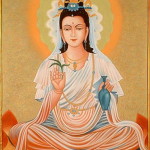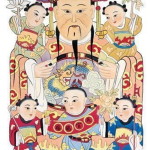Kwan-yin (“Goddess of Mercy”) was translated from “Avalokites’ Vara” in Sanskrit. As one of the four major Bodhisattvas in Buddhism, he is highly valued by Buddhists in China. With dignified and kind facial appearance, Kwan-yin, who holds a clean bottle with a twig of willow in his hand, is regarded to have infinite wisdom and theurgy. He was said to be infinitely merciful and apt at rescuing the human world from disasters as well as hearing and viewing tribulations in it. Therefore, he was called “Goddess of Mercy”.
Kwan-yin was introduced to China in the Three Kingdoms Period. The image at that time was a martial man, similar to those painted in frescos (with a pair of pretty moustaches above the lip) in Mogao Grottoes in Dunhuang, Gansu Province and statues of the Southern and Northern Dynasty. It is in the Southern and Northern Dynasty that Kwan-yin had female appearance. According to what was said by Buddhists, Kwan-yin was good at changing images. That is why Kwan-yin presents female appearance. There are many interesting legends about Kwan-yin’s diversified images going round in China. Kwan-yin’s female image in China is featured by kindness and clemency, which is in conformity with Chinese women’s mercifulness and kindheartedness. This can reflect to some extent Chinese Buddhists’ devoutness and godliness shown to Kwan-yin. For this reason, it is prevalent among common people to worship Son-giving Kwan-yin and Thousand-arm Kwan-yin, praying for good luck.
Kwan-yin bodhimandala in China is located on Putuo Mountain in Zhejiang Province. Legend has it that in ancient times, a Japanese monk intended to take Kwan-yin statue to his country. However, his plan was frustrated by storms at the South China Sea. Under this circumstance, he decided to build a Kwan-yin bodhimandala on Putuo Mountain. There is still a “Decline to leave” Kwan-yin Temple (supposedly as the first temple built by the Japanese monk) standing on the mountain.
When stepping on Chinese territory, you will see numerous Kwan-yin temples, Kwan-yin halls and Kwan-yin cavities of all sizes. Also, you will have the opportunity to taste the Tieh- Kwan -Yin tea. It seems that the placid, merciful and cordial Kwan-yin can be seen everywhere in China.








发布产品咨询